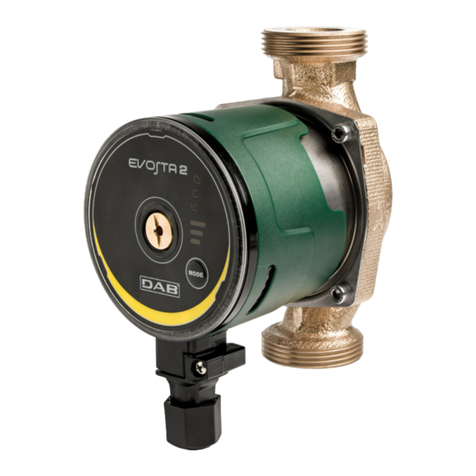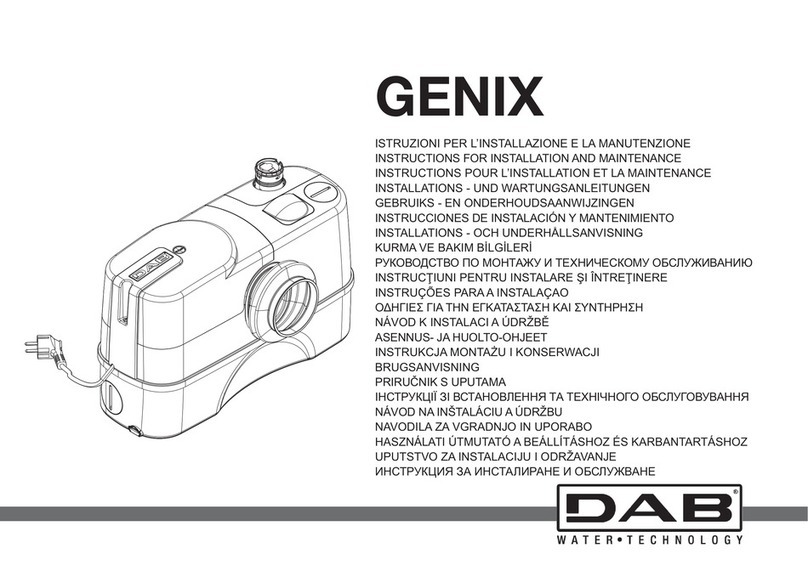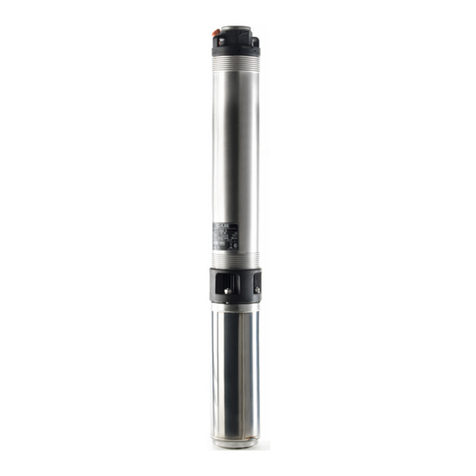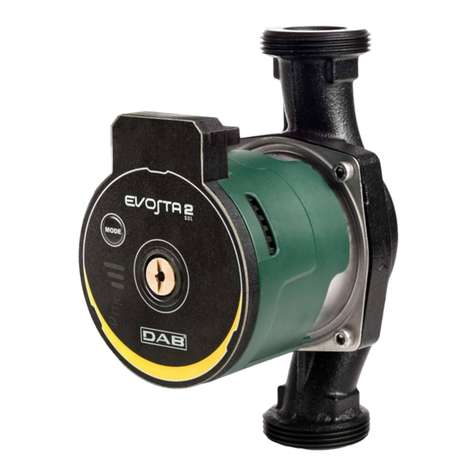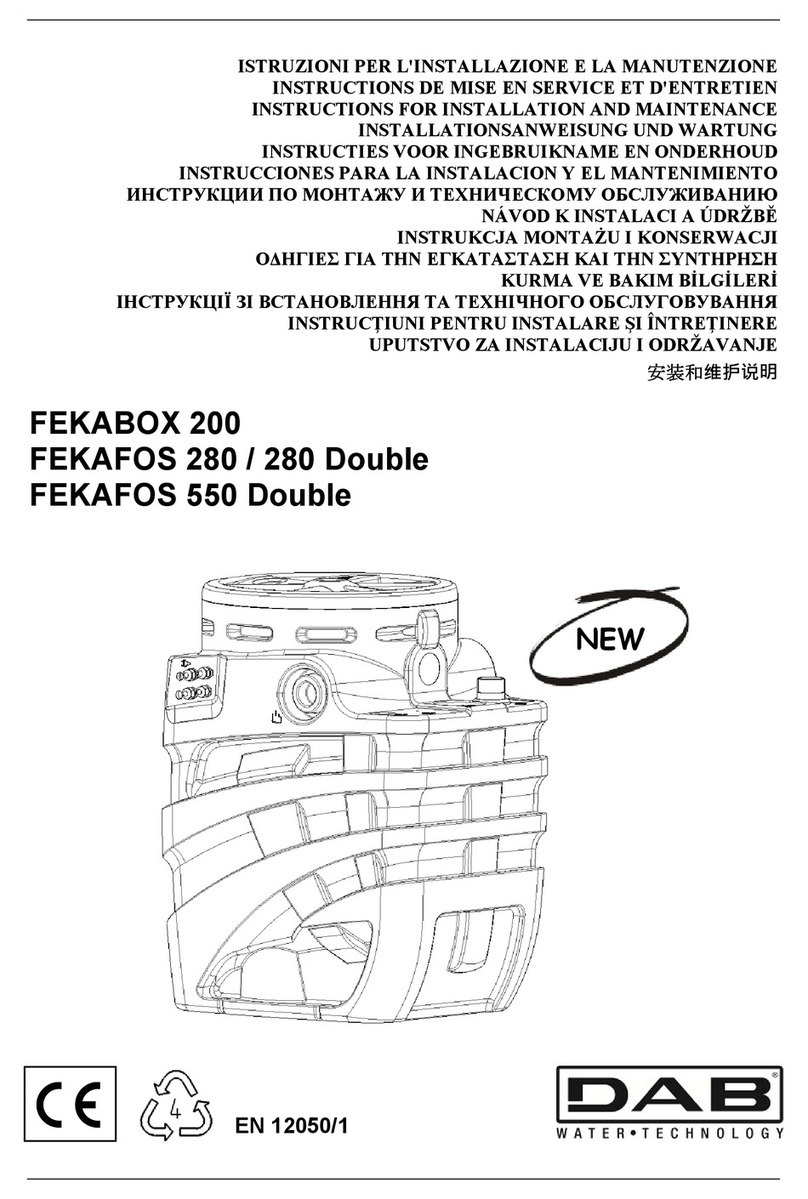
ENGLISH
GB
63
operation of the electropump always and only at maximum power.operation of the electropump always and only at maximum power.
The system is congured by the manufacturer to satisfy the majority of The system is congured by the manufacturer to satisfy the majority of
installation cases, that is:installation cases, that is:
•• Operation at constant pressure;Operation at constant pressure;
•• Set-Point (desired value of constant pressure:SP = 3.0 barSet-Point (desired value of constant pressure:SP = 3.0 bar
•• Reduction of pressure to restart: RP = 0.3 barReduction of pressure to restart: RP = 0.3 bar
•• Anti-cycling function: DisabledAnti-cycling function: Disabled
However, these parameters and others can be set according to the sys-However, these parameters and others can be set according to the sys-
tem. All the settable values are illustrated in the par. 5-6-7: pressure, inter-tem. All the settable values are illustrated in the par. 5-6-7: pressure, inter-
vention of protections, rotation speed, etc.vention of protections, rotation speed, etc.
There are many other operating modes and accessory functions. Thanks There are many other operating modes and accessory functions. Thanks
to the dierent possible settings and the availability of congurable input to the dierent possible settings and the availability of congurable input
and output channels, it is possible to adapt the inverter operation to the and output channels, it is possible to adapt the inverter operation to the
requirements of various systems. See 5-6-7.requirements of various systems. See 5-6-7.
1.21.2 Integrated Expansion VesselIntegrated Expansion Vessel
The system is complete with an integrated expansion vessel with a total The system is complete with an integrated expansion vessel with a total
capacity of 2 litres. The main functions of the expansion vessel are:capacity of 2 litres. The main functions of the expansion vessel are:
•• to make the system elastic so as to protect it against water ham-to make the system elastic so as to protect it against water ham-
mer;mer;
•• to ensure a water reserve which, in the case of small leaks, main-to ensure a water reserve which, in the case of small leaks, main-
tains the pressure in the system for a longer time and spreads out tains the pressure in the system for a longer time and spreads out
needless restarts of the system which otherwise would be contin-needless restarts of the system which otherwise would be contin-
uous;uous;
•• when the utility is turned on, ensure the water pressure for the when the utility is turned on, ensure the water pressure for the
seconds that the system takes to switch on and reach the correct seconds that the system takes to switch on and reach the correct
rotation speed.rotation speed.
It is not a function of the integrated expansion vessel to ensure a water re-It is not a function of the integrated expansion vessel to ensure a water re-
serve such as to reduce interventions of the system (requests from the util-serve such as to reduce interventions of the system (requests from the util-
ity, not from a leak in the system). It is possible to add an expansion vessel ity, not from a leak in the system). It is possible to add an expansion vessel
with the capacity you prefer to the system, connecting it to a point on the with the capacity you prefer to the system, connecting it to a point on the
delivery system (not a suction point!). In the case of horizontal installation delivery system (not a suction point!). In the case of horizontal installation
it is possible to connect to the unused delivery outlet. When choosing the it is possible to connect to the unused delivery outlet. When choosing the
tank, consider that the quantity of water released will also depend on the tank, consider that the quantity of water released will also depend on the
parameters SP and RP that can be set on the system (par.6-7).parameters SP and RP that can be set on the system (par.6-7).
The expansion vessel is preloaded with pressurised air through the valve The expansion vessel is preloaded with pressurised air through the valve
accessible from the technical compartment (Fig.3, point 1). The preload accessible from the technical compartment (Fig.3, point 1). The preload
value with which the expansion vessel is supplied by the manufacturer is value with which the expansion vessel is supplied by the manufacturer is
in agreement with the parameters SP and RP set as default, and anyway it in agreement with the parameters SP and RP set as default, and anyway it
satises the following equation:satises the following equation:
Pair = SP – RP – 0.7bar Where:Pair = SP – RP – 0.7bar Where:
- Pair = air pressure value in bar - Pair = air pressure value in bar
- SP = Set Point (par.7.3) in bar - SP = Set Point (par.7.3) in bar
- RP = Reduction of pressure to restart - RP = Reduction of pressure to restart
(par. 7.5.1) in bar (par. 7.5.1) in bar
So, by the manufacturer: Pair = 3.0 – 0.3 – 0.7 = 2.0 barSo, by the manufacturer: Pair = 3.0 – 0.3 – 0.7 = 2.0 bar
If dierent values are set for the parameters SP and/or RP, regulate the If dierent values are set for the parameters SP and/or RP, regulate the
valve of the expansion vessel releasing or letting in air until the above valve of the expansion vessel releasing or letting in air until the above
equation is satised again (e.g.: SP=2.0bar; RP=0.3bar; release air from equation is satised again (e.g.: SP=2.0bar; RP=0.3bar; release air from
the expansion vessel until a pressure of 1.0 bar is reached on the valve).the expansion vessel until a pressure of 1.0 bar is reached on the valve).
Failure to respect the above equation may lead to malfunctions Failure to respect the above equation may lead to malfunctions
of the system or to premature breakage of the diaphragm inside of the system or to premature breakage of the diaphragm inside
the expansion vessel. the expansion vessel.
Considering the expansion vessel capacity of only 2 litres, any Considering the expansion vessel capacity of only 2 litres, any
operation to check the air pressure must be performed by con-operation to check the air pressure must be performed by con-
necting the pressure gauge very rapidly: on small volumes the necting the pressure gauge very rapidly: on small volumes the
loss of even a limited quantity of air can cause an appreciable loss of even a limited quantity of air can cause an appreciable
drop in pressure. The quality of the expansion vessel ensures drop in pressure. The quality of the expansion vessel ensures
the maintenance of the set air pressure value, proceed to check the maintenance of the set air pressure value, proceed to check
it only at calibration or if you are sure of a malfunction.it only at calibration or if you are sure of a malfunction.
Any operation to check and/or reset the air pressure must be per-Any operation to check and/or reset the air pressure must be per-
formed with the delivery system not under pressure: disconnect formed with the delivery system not under pressure: disconnect
the pump from the power supply and open the utility nearest to the pump from the power supply and open the utility nearest to
the pump, keeping it open until it no longer gives any water.the pump, keeping it open until it no longer gives any water.


